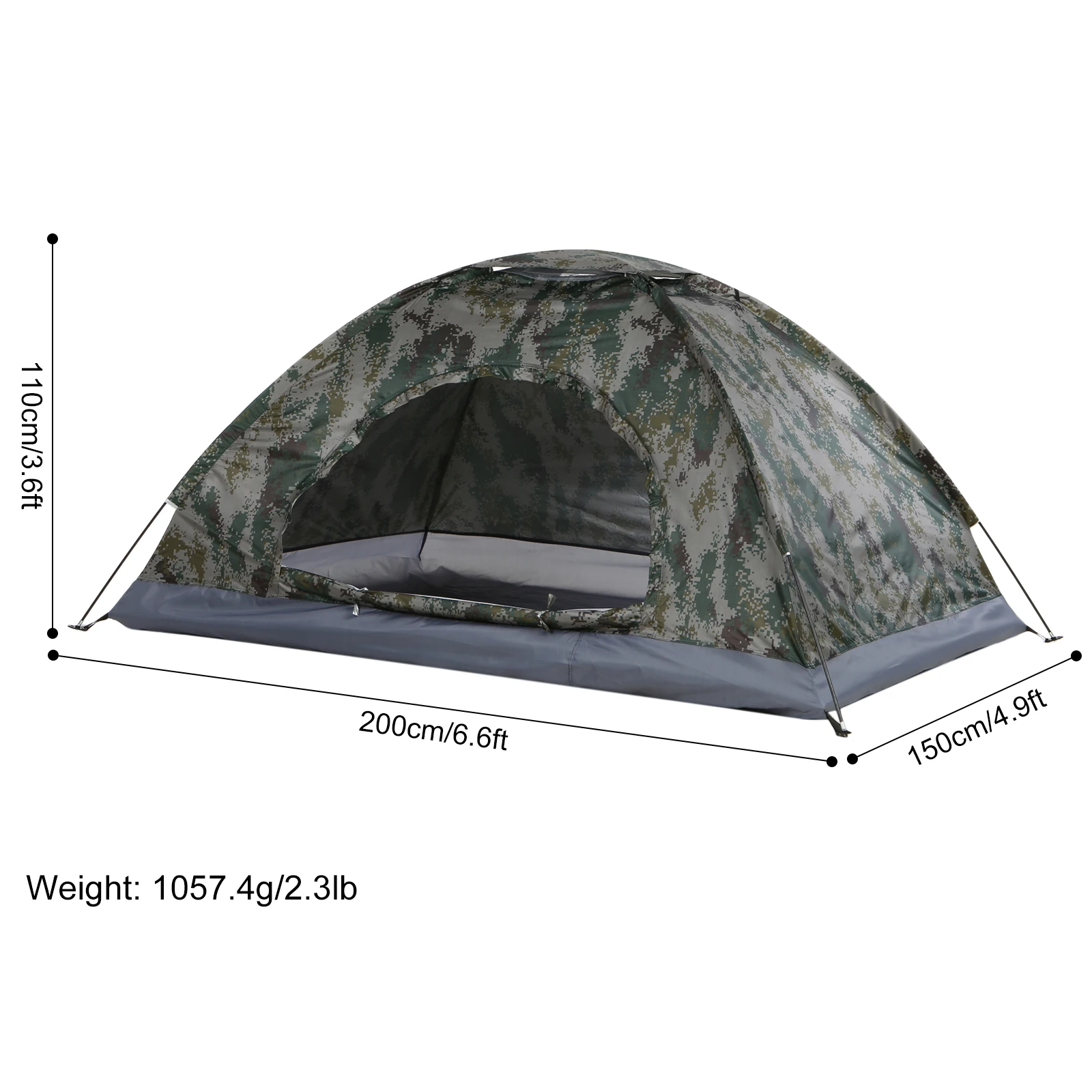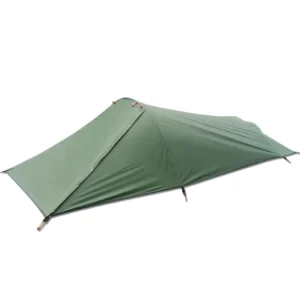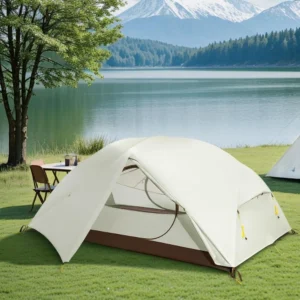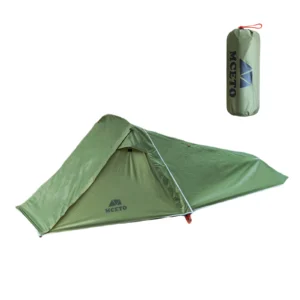Introduction: Understanding Your Ultralight Shelter Options
When venturing into the backcountry, few gear choices impact your experience as profoundly as your shelter selection. For serious backpackers, this decision often comes down to a critical balancing act between weight savings and protection from the elements. This balance is at the heart of the single-wall versus double-wall tent debate.
The difference between these tent types can mean carrying up to 2 pounds (0.9 kg) less weight—a significant consideration when every ounce matters on long trails. Yet weight is just one factor in a complex decision that affects your comfort, safety, and enjoyment in the wilderness.
Single-wall tents use one layer of fabric that serves as both living space and weather protection. Double-wall tents separate these functions with an inner tent (typically mesh and floor) and an outer rainfly. This fundamental design difference creates a cascade of performance tradeoffs that every backpacker must navigate.
This guide will help you understand the nuances of both designs, comparing their performance across various conditions and uses. By examining everything from condensation management to setup efficiency, you’ll gain the knowledge needed to select the perfect shelter options for two campers or solo adventures based on your unique needs.
Key takeaways:
* The tent you choose significantly impacts pack weight, comfort, and weather protection
* Each design excels in different environments and conditions
* Your personal priorities should guide your selection
What Defines Single-Wall and Double-Wall Ultralight Tents?
Before diving into comparisons, let’s establish clear definitions of these two fundamentally different shelter designs:
Single-Wall Tents
Single-wall tents consist of just one layer of fabric that serves as both the living space boundary and the weather barrier. This minimalist approach eliminates the separate rainfly found in traditional tents. Most ultralight single-wall tents use waterproof-breathable fabrics or strategic ventilation features to manage moisture. Many models replace conventional tent poles with trekking pole support, further reducing weight.
Double-Wall Tents
Double-wall tents feature two distinct layers: an inner tent (typically mesh with a waterproof floor) and a separate waterproof rainfly. This creates an air gap between layers that helps manage condensation and temperature regulation. The inner tent provides bug protection and living space, while the outer rainfly handles weather protection.
The evolution of ultralight backpacking has driven innovation in both designs. Single-wall tents gained popularity among thru-hikers and alpinists seeking absolute weight minimization. Double-wall designs have progressively shed weight through advanced materials and clever engineering to remain competitive while maintaining their inherent advantages.
Materials play a crucial role in both designs. Modern ultralight backpacking tent models utilize specialized fabrics like Dyneema Composite Fabric (formerly Cuben Fiber), silnylon, and silpoly—each offering different performance characteristics that we’ll explore later in this guide.
Head-to-Head Comparison: Key Performance Factors
This comparison chart provides a quick reference guide to the fundamental differences between these tent types across critical performance metrics:
| Performance Factor | Single-Wall Tents | Double-Wall Tents |
|---|---|---|
| Weight | Typically 15-30% lighter | Heavier but closing the gap with new materials |
| Packability | More compact packed size | Requires more pack volume |
| Weather Protection | Good in most conditions; challenges in sustained precipitation | Excellent across varied conditions |
| Condensation Management | Prone to interior condensation | Superior moisture control via air gap |
| Setup Complexity | Generally simpler, fewer pieces | More components, potentially longer setup |
| Setup Time | Typically 2-4 minutes | Typically 4-7 minutes |
| Durability | Often uses lighter materials with lower denier ratings | Usually more robust with redundancy |
| Interior Space | Varies by design; can maximize space-to-weight ratio | Often more livable with vertical walls |
| Ventilation | Limited to designed vents and doors | Adaptable with multiple configuration options |
| Freestanding Options | Less common | More frequently freestanding |
| Price Range | $300-$700 for premium models | $350-$750 for premium models |
This overview highlights the tradeoffs inherent in each design approach. The right choice ultimately depends on aligning these performance characteristics with your specific needs, priorities, and typical backpacking environments. The subsequent sections will explore each of these factors in greater detail to provide deeper context for your decision-making process.
When choosing the ultimate compact shelter for two, these comparisons become especially important as you balance individual preferences with shared comfort and protection.
The Single-Wall Advantage: When Less is More
Single-wall tents represent the purist’s approach to ultralight backpacking, embodying the “less is more” philosophy. Their streamlined design offers several compelling advantages for weight-conscious adventurers.
Weight Savings: The most obvious benefit is significant weight reduction. By eliminating the separate rainfly, single-wall tents typically save between 8-16 ounces (227-454g) compared to similarly sized double-wall models. For through-hikers covering thousands of miles, this weight difference compounds with every step.
Pack Volume Efficiency: Beyond mere weight, single-wall tents consume considerably less space in your backpack. This compact profile allows for smaller packs or more room for food and water—critical on longer trips between resupply points.
Simplified Setup: With fewer components to manage, single-wall tents generally offer faster setup times. Most can be pitched in under 3 minutes once you’ve mastered the technique, a significant advantage when racing approaching storms or setting up in fading light.
Integrated Design Benefits: Many single-wall tents incorporate clever design elements like catenary curves (slight arcs in seams) that create taut pitches with minimal adjustments. This results in better stability in wind with fewer guy lines and stakes.
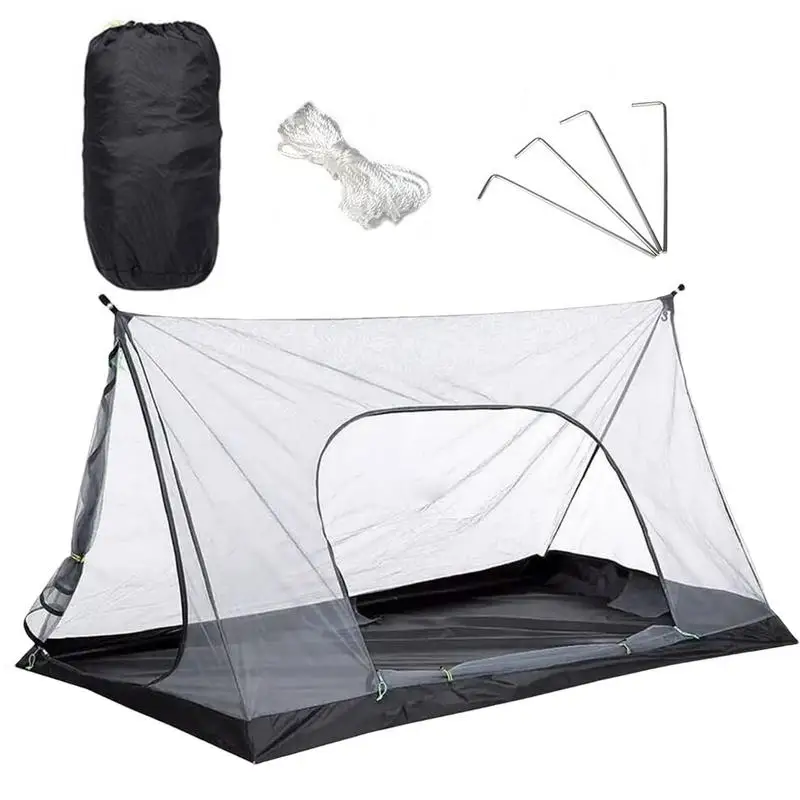
Pros of Single-Wall Tents:
* Lightest possible shelter option (excluding tarps)
* Quickest setup, especially in challenging conditions
* Smallest packed size for limited pack space
* Often use trekking poles for support, eliminating dedicated pole weight
* Simpler design with fewer potential failure points
* Potentially more interior space relative to carried weight
Cons of Single-Wall Tents:
* Significant condensation challenges, especially in humid conditions
* Limited ventilation options compared to double-wall designs
* Sometimes requires more careful site selection
* Can be more challenging to access during sustained precipitation
* May offer more limited storage options for gear
Single-wall tents shine brightest in environments where moisture management is less critical—desert regions, alpine zones above tree line, and cold, dry conditions. They’re the preferred choice for alpine climbers, ultralight purists, and ultralight trekking pole tent enthusiasts who prioritize weight savings above all else.
Double-Wall Design: The Comfort and Versatility Approach
Double-wall tents take a different approach to backcountry shelter, prioritizing adaptability and comfort while still keeping weight reasonable. Modern materials and design innovations have significantly narrowed the weight gap with single-wall models while maintaining their inherent advantages.
Superior Condensation Management: The defining benefit of double-wall tents is their effective handling of moisture. The air gap between the inner tent and rainfly creates a thermal buffer zone where condensation forms primarily on the rainfly rather than dripping onto occupants and gear. This separation is invaluable in humid environments or during extended rain.
Versatility Through Modularity: Double-wall designs offer configuration options that single-wall tents cannot match. On clear, bug-free nights, you might use only the rainfly with the footprint for minimal weight. In bug season without rain, the inner tent alone provides insect protection with maximum ventilation.
Weather Adaptability: The dual-layer design creates superior performance across varied conditions. The rainfly can be adjusted for ventilation or battened down for storm protection without compromising the living space. This adaptability makes double-wall tents more forgiving in unpredictable weather patterns.
Protected Storage Space: Most double-wall tents feature vestibules that provide sheltered storage for gear without sacrificing interior living space. This separation keeps wet equipment outside your sleeping area while still protected from the elements.
Pros of Double-Wall Tents:
* Excellent condensation management in all conditions
* Adaptable configurations for different environments
* More predictable performance in sustained poor weather
* Protected gear storage in vestibules
* Often more comfortable in a wider range of conditions
* Generally more durable with redundant protection
Cons of Double-Wall Tents:
* Heavier than comparable single-wall models (though the gap is narrowing)
* More time-consuming setup with multiple components
* Larger packed size requires more backpack space
* Typically more expensive for comparable quality
Double-wall tents excel in environments with variable or humid conditions. They’re ideal for backpackers who prioritize sleep quality and comfort, those exploring regions with unpredictable weather, and anyone planning extended trips where reliability trumps absolute weight minimization. Modern freestanding backpacking tent designs have further enhanced the appeal of double-wall configurations by eliminating some traditional setup complexities.
The Condensation Challenge: Managing Moisture in Ultralight Shelters
Condensation is perhaps the most significant practical difference between single and double-wall tents—and often becomes the deciding factor for many backpackers. Understanding this phenomenon helps make an informed shelter choice.
When warm, moist air (from breathing, body heat, or wet gear) contacts a cold surface like tent fabric, water vapor condenses into liquid. In enclosed shelters, this can create significant moisture accumulation overnight. A single person typically releases about 1 pint (0.5 liters) of water vapor through respiration during sleep—all of which must go somewhere.
Single-Wall Condensation Dynamics:
In single-wall tents, condensation forms directly on the interior surface. Without separation between this surface and the living space, moisture often transfers to sleeping bags, clothing, and gear. Manufacturers attempt to mitigate this through waterproof-breathable fabrics and ventilation features, but physics ultimately limits their effectiveness.
Double-Wall Condensation Management:
Double-wall designs address condensation through the air gap between layers. Moisture passes through the breathable inner tent and condenses on the rainfly. This keeps the living space relatively dry even in challenging conditions. The tradeoff is additional weight from the second layer of material.
Universal Condensation Strategies:
Regardless of tent design, these practices help minimize moisture problems:
* Maximize ventilation whenever weather permits
* Avoid cooking inside your shelter
* Dry wet gear outside the tent when possible
* Choose elevated, well-drained sites away from water sources
* Leave wet items in vestibules rather than the sleeping area
* Wipe down interior surfaces before packing up
Environmental factors dramatically influence condensation severity. Humid environments, temperature drops overnight, and proximity to water sources all increase moisture challenges. Single-wall limitations become most apparent in these conditions, while double-wall designs demonstrate their value.
Understanding proper lightweight tent setup techniques can significantly impact your ability to manage condensation regardless of which design you choose.
Material Science: Fabrics That Make Ultralight Possible
The dramatic weight reduction in modern backpacking tents comes largely from revolutionary materials that offer remarkable performance at a fraction of traditional weights. These specialized fabrics directly influence tent performance, durability, and price.
Dyneema Composite Fabric (DCF)
Formerly known as Cuben Fiber, DCF represents the premium end of ultralight materials. This non-woven composite bonds Dyneema fibers between polyester films, creating an incredibly lightweight yet waterproof material.
* Weight: Extremely light (0.5-0.8 oz/yd² or 17-27 g/m²)
* Waterproofing: Exceptional with no additional coatings needed
* Durability: High tear strength but moderate abrasion resistance
* Stretch: Virtually none (beneficial for maintaining taut pitch)
* Cost: Very expensive (often 2-3x more than other materials)
Silnylon (Silicone-Impregnated Nylon)
The long-standing standard for lightweight tents, silnylon impregnates nylon fabric with silicone on both sides for waterproofing.
* Weight: Light (1.1-1.5 oz/yd² or 37-51 g/m²)
* Waterproofing: Good but may require occasional retreatment
* Durability: Good balance of tear and abrasion resistance
* Stretch: Considerable, especially when wet (requires readjustment)
* Cost: Moderate and widely available
Silpoly (Silicone-Impregnated Polyester)
A newer alternative that addresses some silnylon limitations, particularly stretch when wet.
* Weight: Similar to silnylon
* Waterproofing: Good with more consistent performance when wet
* Durability: Less initial strength than silnylon but more stable over time
* Stretch: Minimal even when wet
* Cost: Comparable to silnylon
PU-Coated Fabrics
Polyurethane coatings offer a more affordable waterproofing solution but with performance tradeoffs.
* Weight: Varies widely based on base fabric
* Waterproofing: Good initially but degrades faster than silicone
* Durability: Coating may peel or degrade over time
* Stretch: Depends on base fabric
* Cost: Generally the most affordable option
The material choice significantly impacts which tent might be considered truly ultralight. Each fabric has distinct advantages in specific conditions—Dyneema’s weightlessness and waterproofing excel in alpine environments, while silpoly’s dimensional stability performs well in varied conditions with less adjustment needed.
Manufacturers often use different materials for different tent components to balance performance and cost. Floor fabrics typically use higher denier (thicker) materials for durability, while rainflies and canopies utilize lighter options to save weight where possible.
Weather Resistance: Protection When It Matters Most
When severe weather strikes in the backcountry, your tent becomes your lifeline. The structural and material differences between single and double-wall tents significantly impact their weather performance.
Rain Protection Dynamics:
Double-wall tents generally handle sustained precipitation more effectively. The separate rainfly can shed water continuously without affecting the inner living space. Entry and exit during rainstorms remains more manageable as the inner tent stays protected while the fly door opens.
Single-wall tents perform adequately in most rain conditions but face challenges during prolonged storms. Water can sometimes seep through high-stress areas or enter during entry/exit. The condensation issues mentioned earlier become more pronounced during rainy periods.
Wind Performance:
Wind resistance depends more on pole structure than wall design. However, double-wall tents often incorporate more poles and attachment points, potentially offering better stability. The best single-wall designs compensate with strategic guy-out points and aerodynamic shapes.
Temperature Management:
The air gap in double-wall tents provides thermal insulation benefits in cold weather. This buffer zone helps stabilize interior temperatures and reduces heat loss through conduction. Single-wall tents respond more directly to outside temperature changes, which can be advantageous for quick warming in morning sun but less desirable in rapidly changing conditions.
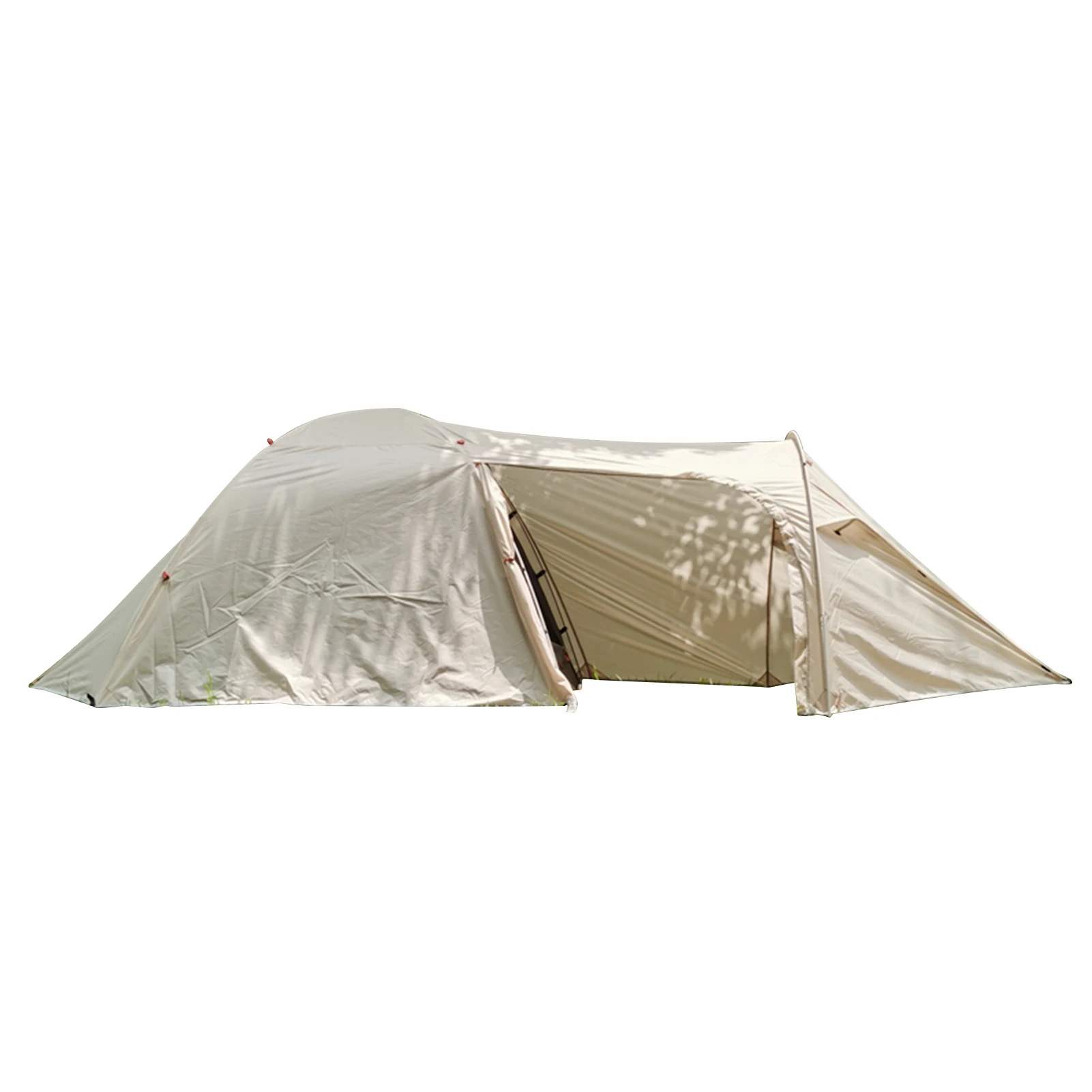
Snow Loading:
For winter camping, double-wall tents typically handle snow loads better due to stronger pole structures and the ability to shed snow from the rainfly without compromising interior space. Purpose-built winter single-wall tents exist but require specialized design features to match this performance.
Hydrostatic Head Considerations:
Most quality backpacking tents offer waterproofing ratings of 1,200-3,000mm hydrostatic head on rainflies and 2,000-5,000mm on floors. These ratings reflect the water pressure the fabric can withstand before leaking. The numbers alone don’t tell the whole story—seam sealing, design features, and proper pitching significantly impact real-world performance.
For all-weather protection, waterproof backpacking tent designs prioritize features that work together as a system rather than relying on any single element.
Setup Efficiency: Getting Shelter When You Need It
Setup speed and simplicity become crucial when you’re racing daylight or incoming weather. The fundamental design differences between single and double-wall tents create distinct setup experiences.
Single-Wall Setup Process:
1. Lay out tent body flat, orienting door as desired
2. Stake out corners (typical sequence varies by model)
3. Insert trekking poles or assemble dedicated poles
4. Tension guy lines as needed
5. Make final adjustments for taut pitch
Average setup time: 2-4 minutes for experienced users
Double-Wall Setup Process:
1. Lay out tent footprint (if used)
2. Position inner tent and stake corners
3. Assemble and insert pole structure
4. Attach inner tent to pole framework
5. Drape rainfly over assembled inner tent
6. Attach rainfly to inner tent or stakes
7. Tension guy lines and make adjustments
Average setup time: 4-7 minutes for experienced users
Freestanding vs. Non-Freestanding Considerations:
Freestanding tents (which stand without stakes) offer flexibility for positioning and surface adaptability, though they typically weigh more due to comprehensive pole structures. Non-freestanding designs save weight but require suitable staking ground and more careful site selection.
The freestanding vs. non-freestanding ultralight tents question often intersects with the single vs. double-wall decision, as many (though not all) single-wall tents are non-freestanding while double-wall designs more commonly feature freestanding structures.
Stake and Guy Line Requirements:
Single-wall tents typically require 6-8 stakes for a secure pitch
Double-wall tents generally need 8-12 stakes for complete setup with vestibules
Additional guy lines (typically 2-4) provide crucial stability in adverse conditions for both designs
Even with theoretical differences in setup complexity, individual tent models vary widely. Many backpackers find that familiarity and practice influence setup time more than wall design alone.
Livability and Comfort: Your Home in the Backcountry
While weight often dominates ultralight tent discussions, livability features determine your day-to-day satisfaction with your shelter choice. Both single-wall and double-wall tents can provide comfortable backcountry living spaces, but with different approaches and trade-offs.
Interior Space Utilization:
Most ultralight tents (both types) offer between 18-25 square feet (1.7-2.3 square meters) of floor space for one-person models and 28-35 square feet (2.6-3.3 square meters) for two-person designs. However, usable space varies significantly based on:
- Wall steepness (vertical walls maximize usable space)
- Peak height (typically 40-48 inches/102-122 cm in ultralight models)
- Interior width at shoulder and foot areas
- Headroom distribution throughout the tent
Storage and Vestibules:
Double-wall tents typically excel in storage design with well-developed vestibules integrated into the rainfly. These protected spaces keep wet gear outside the sleeping area while still sheltered from rain. Single-wall designs often have more limited vestibules or require choosing between gear storage and easy entry/exit.
Ventilation Approaches:
Ventilation directly impacts comfort through temperature regulation and condensation management:
* Double-wall designs offer adjustable ventilation options through the rainfly
* Single-wall tents rely on fixed vents, doors, and material breathability
* Cross-ventilation possibilities vary significantly between specific models
The importance of maximizing space and comfort in ultralight shelters cannot be overstated for multi-day adventures. Small design differences become increasingly significant as trip length increases.
Psychological Comfort Factors:
Beyond physical measurements, tents provide psychological comfort through:
* Protection from insects and other wildlife
* Visual privacy from other campers
* Noise reduction from wind and rain
* A sense of security in unfamiliar surroundings
Double-wall designs often provide stronger psychological comfort through their more substantial feel and separate bug protection layer, though well-designed single-wall tents can achieve similar effects with less weight.
Durability Considerations: Longevity in the Field
Ultralight gear inevitably involves compromises in durability. Understanding these trade-offs helps set appropriate expectations and maintenance routines for your tent investment.
Common Failure Points:
Single-wall tents typically show greatest wear at:
* Stress points where trekking poles contact fabric
* Door zippers exposed to elements
* Seam tape degradation over time
* Abrasion at ground contact points
Double-wall tents most commonly fail at:
* Pole connection points on the inner tent
* Rainfly zippers and attachment points
* Floor perimeter where tension occurs
* Lightweight pole segments
Field Repairability:
Single-wall tents generally offer simpler field repairs since access to damaged areas is direct. Double-wall designs may require more complex repairs when damage occurs at interface points between layers.
Essential repair items for both designs include:
* Tenacious Tape or similar repair patches
* Seam sealer
* Spare guy line
* Pole repair sleeve
Expected Lifespan:
With proper care, quality ultralight tents typically provide:
* 100-200 nights for intensive use (thru-hiking, guide work)
* 5-10 years for occasional backpackers (weekend trips)
* Longer lifespans when used primarily in mild conditions
Material denier ratings provide some durability guidance—higher numbers indicate thicker, more durable fabrics at the cost of additional weight. Floor fabrics typically range from 15-30 denier in ultralight tents, while rainfly materials range from 7-20 denier depending on the material type and tent purpose.
Understanding durability in ultralight hiking tents helps manage expectations and maintenance routines that maximize the lifespan of your investment. The most crucial factor in tent longevity is proper care—appropriate drying, storage, and transport protection significantly extend the functional life of any tent design.
Decision Matrix: Finding Your Perfect Ultralight Shelter
Choosing between single and double-wall designs requires honest assessment of your priorities, backpacking style, and typical environments. This framework helps match your specific needs with the ideal tent type.
Primary Environmental Considerations:
* Humid or rainy regions: Double-wall strongly preferred for condensation management
* Arid deserts or alpine zones: Single-wall may offer adequate performance at lower weight
* Mixed conditions with variable weather: Double-wall provides greater adaptability
* Winter and snow camping: Specialized versions of either design can work; ventilation is crucial
Trip Duration Factors:
* Weekend adventures: Either design works well; weight savings less critical
* Week-long excursions: Performance features gain importance
* Thru-hiking: Weight and packed size become increasingly critical
* Base camping with day hikes: Comfort features merit priority
Personal Priority Assessment:
* Weight minimalism above all: Single-wall designs excel
* Comfort prioritization: Double-wall typically offers better livability
* Versatility across conditions: Double-wall provides more adaptability
* Setup simplicity and speed: Single-wall generally offers advantages
Backpacker Profile Recommendations:
The Long-Distance Thru-Hiker
Typically prefers single-wall designs with trekking pole support to maximize weight savings. Willing to adapt techniques to manage condensation in exchange for carrying less weight over thousands of miles.
The Weekend Warrior
Often benefits from double-wall versatility since the weight penalty is less significant on shorter trips. Comfort features enhance limited time outdoors.
The All-Season Adventurer
Generally finds double-wall designs more adaptable across varying conditions, with the option to use different configurations as environments change.
The Budget-Conscious Backpacker
May find better value in double-wall designs from established brands, as quality single-wall tents often command premium prices due to specialized materials and construction.
When considering camping shelter options for two, these decision factors become even more important as you balance individual preferences with shared comfort needs.
Specialized Considerations: Beyond the Basics
Beyond the core comparison, several specialized scenarios merit additional attention when choosing between single and double-wall ultralight tents.
Winter Camping Considerations:
Winter conditions create unique challenges for any shelter:
* Condensation freezes rather than evaporating
* Snow loading requires stronger structural support
* Setup with gloves demands simpler designs
* Interior space needs increase with bulkier winter gear
Purpose-built winter tents in either category incorporate features like additional vents, stronger poles, and snow skirts. Double-wall designs typically perform better in sustained winter conditions due to the insulating air gap and condensation management, though specialized single-wall mountaineering tents can excel in alpine environments.
High-Altitude Performance:
Above treeline, considerations shift:
* Wind exposure becomes more critical
* UV degradation accelerates
* Temperature fluctuations amplify
* Precipitation often falls as snow rather than rain
Both designs can function well at altitude with proper features. Single-wall tents need excellent ventilation systems, while double-wall models benefit from stronger pole structures for wind resistance.
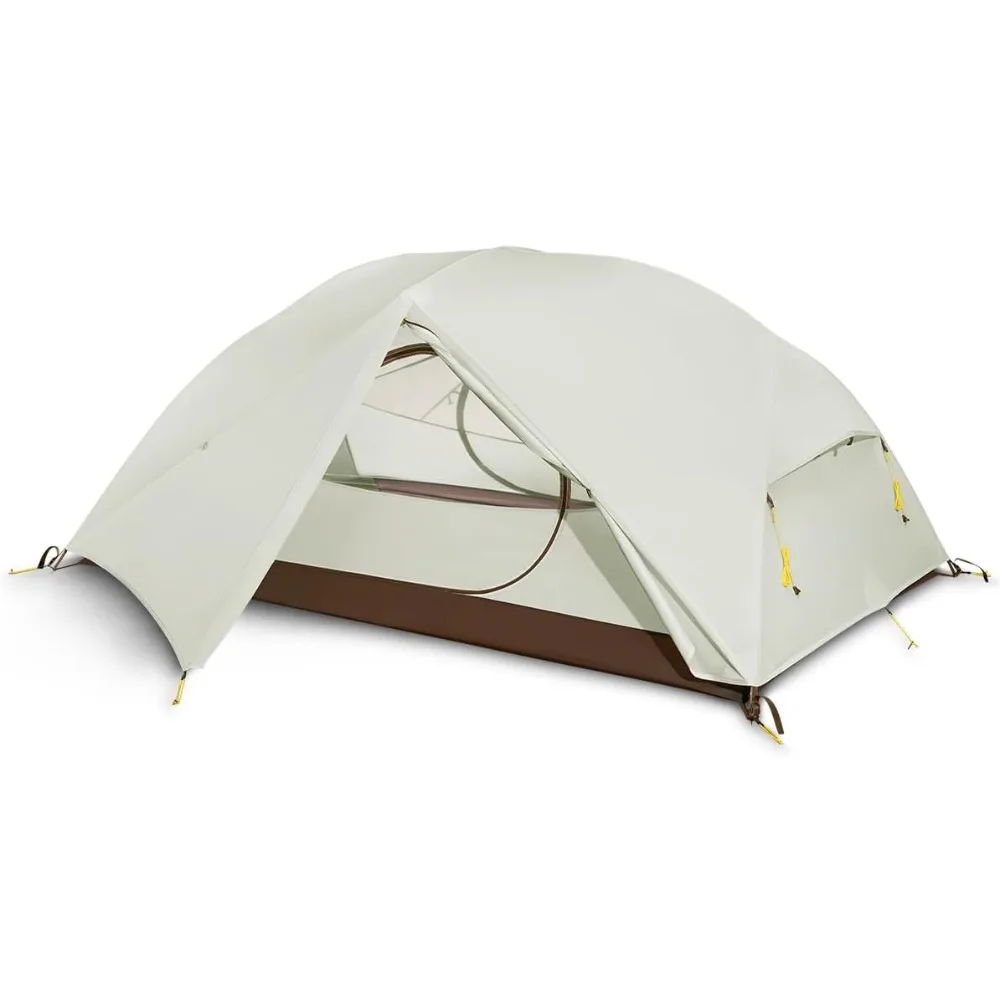
Multiple Occupant Dynamics:
Sharing a tent introduces additional factors:
* Condensation increases proportionally with each occupant
* Entry/exit convenience affects both users
* Interior organization becomes more important
* Soundproofing and privacy factors influence satisfaction
Double-wall tents generally handle multiple occupants better due to superior condensation management and often more thoughtful interior organization features.
Lightweight Backpacking Tent, Ultralight Backpacking Tent, Ultralight Bivy Tent
Ultralight Single Person Camping Tent with Aluminum Poles for 3-Season Backpacking Waterproof DesignPrice range: $94.88 through $326.82 Select options This product has multiple variants. The options may be chosen on the product pageLightweight Backpacking Tent, Ultralight Backpacking Tent, Waterproof Backpacking Tent
$391.05 Select options This product has multiple variants. The options may be chosen on the product pageHeavy Duty 4 Season Tent, Mountaineering Tent, Winter Camping Tent
$870.40 Select options This product has multiple variants. The options may be chosen on the product pageUltralight Backpacking Tent, Ultralight Dome Tent, Winter Camping Tent
Price range: $369.63 through $370.07 Select options This product has multiple variants. The options may be chosen on the product pageHeavy Duty 4 Season Tent, Ultralight Freestanding Tent, Winter Camping Tent
$3,722.66 Select options This product has multiple variants. The options may be chosen on the product pageBackpacking Tent with Vestibule, Freestanding Backpacking Tent, Lightweight Backpacking Tent
Price range: $446.89 through $447.22 Select options This product has multiple variants. The options may be chosen on the product page
When transitioning between environments or planning expeditions in extreme conditions, specialized tent features become crucial. For winter explorers, 4-season winter 2-person tents provide the robust protection needed for harsh conditions while still accommodating a partner or extra gear.
Is There a Perfect Ultralight Tent? Making Your Final Decision
After examining the nuances of single-wall and double-wall designs, the question remains: which is best for you? The answer lies in aligning tent characteristics with your unique needs rather than seeking a universal “best” option.
The ultralight tent landscape continues evolving, with hybrid designs increasingly blurring the line between categories. Some models now incorporate partial double-wall sections in traditionally single-wall designs, addressing condensation hotspots while maintaining weight savings elsewhere.
Consider these final decision-making questions:
* What environmental conditions do you most frequently encounter?
* How much weight are you willing to carry for improved comfort?
* Which aspects of shelter performance matter most to your enjoyment?
* Are you willing to adapt your camping habits to accommodate design limitations?
Personal testing provides invaluable insight beyond specifications and reviews. Consider borrowing or renting before investing in an expensive ultralight tent. Many outdoor retailers offer demo programs, and connecting with local hiking communities can provide opportunities to examine different models firsthand.
Remember that tent selection represents just one component of your overall shelter system. Your choice of groundsheet, sleeping pad, and campsite selection habits significantly influences overall comfort regardless of tent design.
The ideal tent ultimately complements your personal backpacking style rather than forcing adaptation to its limitations.
Maintenance and Care: Extending the Life of Your Ultralight Tent
Proper maintenance significantly extends tent lifespan and maintains optimal performance, regardless of which design you choose.
Cleaning Best Practices:
* Clean with gentle non-detergent soap and lukewarm water
* Never machine wash or dry
* Focus on zipper tracks and pole connection points
* Remove dirt and sand promptly to prevent abrasion
* Avoid commercial fabric cleaners unless specifically tent-approved
Drying and Storage:
* Always dry completely before storage (24+ hours recommended)
* Store loosely in larger storage sack, not compressed
* Keep in climate-controlled environment away from sunlight
* Consider silica gel packets for long-term storage in humid areas
* Avoid basement or attic storage where temperature/humidity fluctuate
Seam Sealing Requirements:
* Factory-sealed tents typically need resealing every 1-3 seasons
* Apply seam sealer when water stops beading on seams
* Focus on high-stress areas (ridgelines, pole attachments)
* Different tent materials require specific compatible sealants
UV Protection Measures:
* Minimize prolonged direct sun exposure when possible
* Consider UV-blocking spray for tents frequently used at altitude
* Expect 30-50% strength reduction after extensive UV exposure
* DCF (Dyneema) offers better UV resistance than nylon
Regular inspection before and after trips helps identify small issues before they become critical failures. Look for fabric wear, seam separation, zipper function, and pole integrity. Address minor damage immediately to prevent expansion.
FAQ: Common Questions About Ultralight Tents
Can single-wall tents be completely condensation-free?
No tent design eliminates condensation entirely. Single-wall tents will always face greater condensation challenges due to physics—warm moist air inside contacting cooler fabric surfaces causes condensation. Strategic ventilation and site selection can significantly reduce but not eliminate this issue.
Are double-wall tents always significantly heavier?
Not necessarily. Modern materials have narrowed the gap considerably. While single-wall tents maintain a weight advantage, premium double-wall models using advanced materials can approach similar weights. The difference might be 4-12 ounces (113-340g) rather than pounds.
Can I use a single-wall tent in extended rainy conditions?
Yes, but with adaptations. Careful site selection, maximizing ventilation when possible, and wiping down interior surfaces periodically becomes important. Expect more challenging moisture management compared to double-wall designs.
Are dedicated tent poles necessary or can I always use trekking poles?
Many ultralight tents can use trekking poles for support, saving significant weight. However, this requires compatible trekking poles of appropriate length and strength. Dedicated poles provide more setup flexibility and consistent performance but add weight.
How much should I expect to spend on a quality ultralight tent?
Premium ultralight tents typically cost $300-750. Single-wall Dyneema tents often represent the upper end of this range, while quality double-wall silnylon/silpoly models fall in the middle. Budget-friendly options exist but usually involve weight or durability compromises.
Is a footprint necessary with an ultralight tent?
While not strictly necessary, footprints provide valuable protection for lightweight tent floors. Many backpackers use lightweight alternatives like Tyvek or polycro sheeting to save weight while still protecting their investment.
How often should I reapply DWR or seam sealer?
This varies by usage, but typically:
* DWR: When water stops beading on fabric (usually every 10-20 nights of use)
* Seam sealer: Every 30-50 nights or when seams show leakage
Expert Tips: Mastering Your Ultralight Shelter
Perfect your site selection – Look for natural windbreaks, avoid low areas where cold air and moisture collect, and clear sharp objects that could damage lightweight floors.
Practice setup before backcountry trips – Efficiency comes with familiarity; practice in various conditions to develop muscle memory for quick deployment when it matters.
Create a modular system – Use your tent in conjunction with other components (groundsheet, bivy, tarp) to adapt to changing conditions without carrying excess weight.
Optimize stake angles – Place stakes at 45° angles away from the tent for maximum holding power, especially critical for non-freestanding designs.
Use natural anchors when possible – Rocks, trees, and roots can replace stakes in rocky terrain, saving weight and providing more secure anchoring.
Prevent condensation proactively – Leave doors/vents maximally open when weather permits, cook outside and away from your tent, and avoid setting up near water sources.
Pack strategically – Position your tent where it’s accessible in case of sudden weather changes, typically near the top or in an external pocket.
Create field repair capability – Carry tenacious tape, spare guy line, and a pole repair sleeve even on short trips to handle emergency repairs.
A Look Ahead: Innovations in Ultralight Tent Design
The ultralight tent market continues evolving with exciting developments that might influence your future shelter choices:
Material Innovations
New fabric technologies are emerging that promise further weight reductions while improving durability. Manufacturers are developing composites that combine the best properties of multiple materials—the waterproofing of Dyneema with the texture and durability of woven fabrics.
Hybrid Design Approaches
The line between single and double-wall tents continues blurring. Partial double-wall sections in otherwise single-wall designs target condensation-prone areas. Some models feature removable interior liners that can be added or removed as conditions dictate.
Sustainability Developments
Eco-friendly materials are gaining prominence in the outdoor industry. Recycled fabrics, PFC-free waterproofing treatments, and repair-focused design show increasing awareness of environmental impact beyond just weight reduction.
Climate Adaptation
As weather patterns become less predictable, adaptability features gain importance. Quick-conversion designs allow rapid response to changing conditions, while enhanced ventilation systems address warming climate challenges.
Accessibility Improvements
Setup mechanisms are becoming more intuitive and manageable for users with varying physical capabilities. Simplified connection systems, color-coding, and pre-attached components reduce setup complexity without weight penalties.
These ongoing innovations suggest that future ultralight shelters will continue reducing the compromises inherent in today’s designs. The ideal tent may remain elusive, but the options for finding your perfect shelter continue to improve with each passing season.

